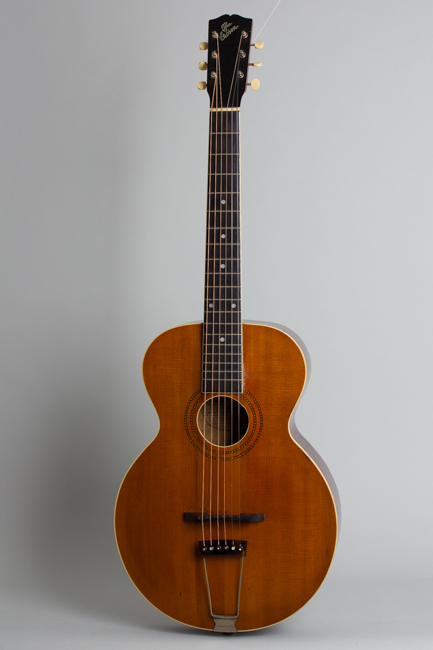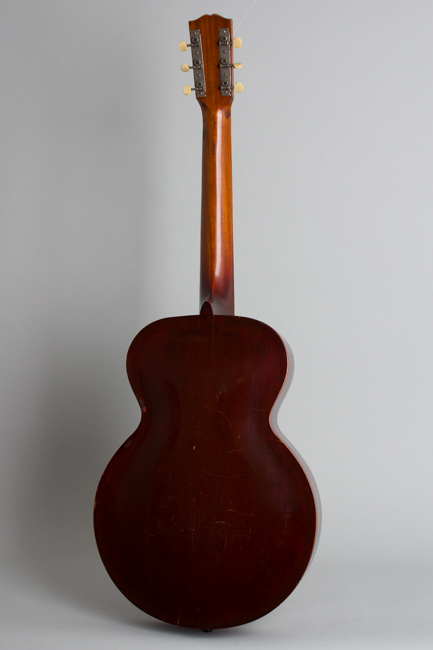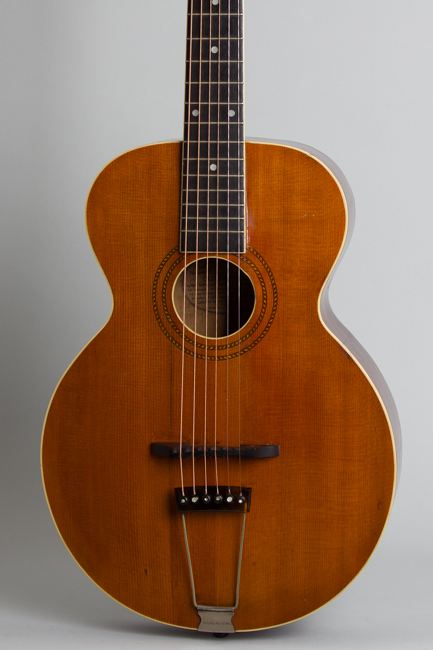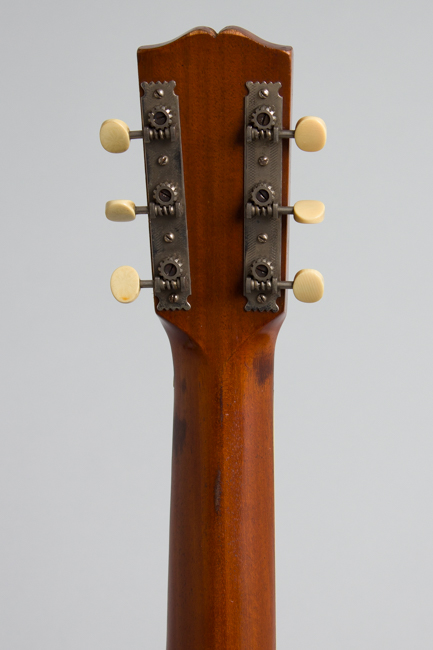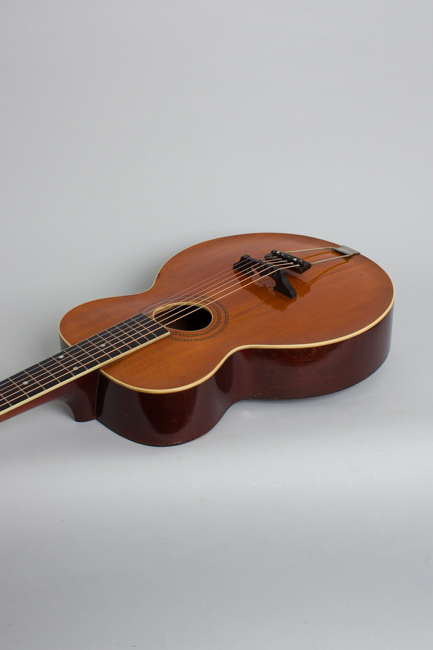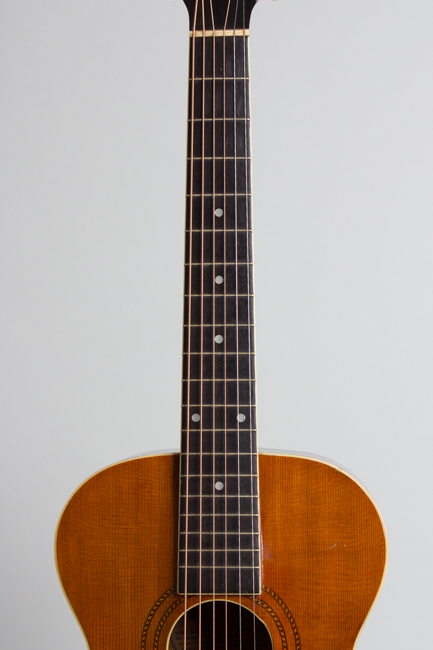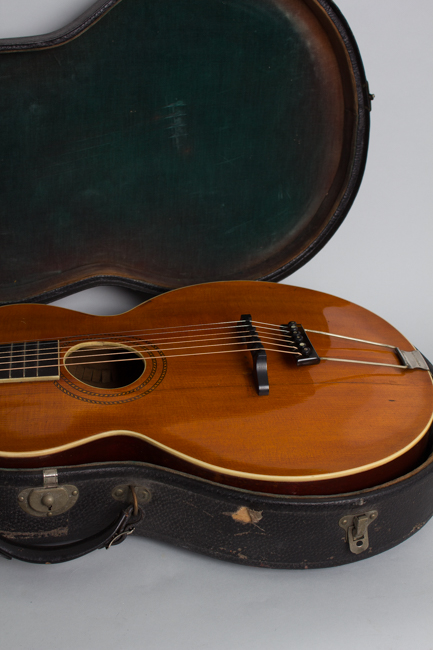Gibson L-1 Arch Top Acoustic Guitar (1917)
Gibson L-1 Model Arch Top Acoustic Guitar (1917), made in Kalamazoo, Michigan, serial # 43089, natural top, cherry stained back and sides finish, birch back and sides, spruce top; mahogany neck with ebony fingerboard, original black hard shell case.
This is not the cleanest original small-body L-1 we have had, but it may be the best sounding! This model was the lowest priced guitar in Gibson's early 1910s line, but still had the company's trademark fully carved top and back. Intended originally primarily as accompaniment for Mandolin orchestras, the early L-1 eventually saw use with early "Hillbilly" bands, vaudeville acts, and even a few primal jazz players before being re-designed as a flat-top instrument in 1926.
When this guitar was made in 1917 the Gibson company was not quite 15 years old; they had achieved dominance in the mandolin market but the guitars definitely took a back seat until the later 1920s. The L-1 is built on a 13 3/4" wide birch body with a carved back and carved spruce top; the chunky mahogany neck has a DEEP soft V profile and is topped with a bound, dot inlaid ebony fingerboard. This one seems slimmer than some we have had. The classic Gibson "open book headstock is topped with a pearl "The Gibson' script logo and carries the same Handel-made strip tuners as all period Gibson's. The carved ebony bridge is mated to the oddball but typical period Gibson Pin-trapeze tailpiece; the pickguard on this one is missing.
At the time this L-1 was made most "good" guitars were still gut strung, steel strings being regarded as cheap and vulgar on a guitar! Martin was only just beginning to experiment with steel string Hawaiian guitars in 1916. The early Gibson archtops were totally unique in their day, louder and punchier than most contemporaries if somewhat lacking in sweetness. This small-body model definitely leans in that direction, but has more breadth to the sound than some we have had. Overall this is a worn in but still fine playing and sounding example, a nice ragtime and early jazz guitar and slightly funky-but-chic cool early Gibson.
Overall length is 38 1/8 in. (96.8 cm.), 13 3/4 in. (34.9 cm.) wide at lower bout, and 3 5/16 in. (8.4 cm.) in depth, measured at side of rim. Scale length is 24 1/2 in. (622 mm.). Width of nut is 1 13/16 in. (46 mm.).
This 107+ year old guitar (now well past its centennial) has seen some wear and repair over the years but is still largely original and quite playable. It remains original except the pickguard is long gone; even the fragile celluloid tailpiece block is intact with 4 of the 6 the original pins (the other 2 are later). The finish has typical micro-checking and light overall wear with dings, dents and scrapes. There is some scarring to the top around the bass side leg of the bridge base. The back has some deeper scratches and the back of the neck has some finish worn down in the first position from play.
There is a notable long grain split repair to the top, running above the string line from back edge right through to above the apex of the soundhole. This is solidly sealed but a bit ugly, looking to have been first sealed up decades ago. There is another short grain split off the treble side of the fingerboard to the soundhole rim, and the top center seam has been resealed as well. There is another pretty ugly repaired crack on the back about 5" long just below the center seam. the back/side seams have been resealed long ago in a few places. All of these repairs are solid if not the neatest.
The tuners, tailpiece and one-piece carved ebony bridge remain original. The original narrow frets are still in decent condition with some wear in the lower positions and the pre-truss rod neck is surprisingly straight and true. This is a worn in but cool old small-body carved guitar with a better sound than many; both richer and fuller than most of these we have had. It survives as a genuine playable relic of Gibson's early days, still in the original HSC with a later handle. Overall Very Good Condition.
This is not the cleanest original small-body L-1 we have had, but it may be the best sounding! This model was the lowest priced guitar in Gibson's early 1910s line, but still had the company's trademark fully carved top and back. Intended originally primarily as accompaniment for Mandolin orchestras, the early L-1 eventually saw use with early "Hillbilly" bands, vaudeville acts, and even a few primal jazz players before being re-designed as a flat-top instrument in 1926.
When this guitar was made in 1917 the Gibson company was not quite 15 years old; they had achieved dominance in the mandolin market but the guitars definitely took a back seat until the later 1920s. The L-1 is built on a 13 3/4" wide birch body with a carved back and carved spruce top; the chunky mahogany neck has a DEEP soft V profile and is topped with a bound, dot inlaid ebony fingerboard. This one seems slimmer than some we have had. The classic Gibson "open book headstock is topped with a pearl "The Gibson' script logo and carries the same Handel-made strip tuners as all period Gibson's. The carved ebony bridge is mated to the oddball but typical period Gibson Pin-trapeze tailpiece; the pickguard on this one is missing.
At the time this L-1 was made most "good" guitars were still gut strung, steel strings being regarded as cheap and vulgar on a guitar! Martin was only just beginning to experiment with steel string Hawaiian guitars in 1916. The early Gibson archtops were totally unique in their day, louder and punchier than most contemporaries if somewhat lacking in sweetness. This small-body model definitely leans in that direction, but has more breadth to the sound than some we have had. Overall this is a worn in but still fine playing and sounding example, a nice ragtime and early jazz guitar and slightly funky-but-chic cool early Gibson.
Overall length is 38 1/8 in. (96.8 cm.), 13 3/4 in. (34.9 cm.) wide at lower bout, and 3 5/16 in. (8.4 cm.) in depth, measured at side of rim. Scale length is 24 1/2 in. (622 mm.). Width of nut is 1 13/16 in. (46 mm.).
This 107+ year old guitar (now well past its centennial) has seen some wear and repair over the years but is still largely original and quite playable. It remains original except the pickguard is long gone; even the fragile celluloid tailpiece block is intact with 4 of the 6 the original pins (the other 2 are later). The finish has typical micro-checking and light overall wear with dings, dents and scrapes. There is some scarring to the top around the bass side leg of the bridge base. The back has some deeper scratches and the back of the neck has some finish worn down in the first position from play.
There is a notable long grain split repair to the top, running above the string line from back edge right through to above the apex of the soundhole. This is solidly sealed but a bit ugly, looking to have been first sealed up decades ago. There is another short grain split off the treble side of the fingerboard to the soundhole rim, and the top center seam has been resealed as well. There is another pretty ugly repaired crack on the back about 5" long just below the center seam. the back/side seams have been resealed long ago in a few places. All of these repairs are solid if not the neatest.
The tuners, tailpiece and one-piece carved ebony bridge remain original. The original narrow frets are still in decent condition with some wear in the lower positions and the pre-truss rod neck is surprisingly straight and true. This is a worn in but cool old small-body carved guitar with a better sound than many; both richer and fuller than most of these we have had. It survives as a genuine playable relic of Gibson's early days, still in the original HSC with a later handle. Overall Very Good Condition.
